스폰지나 약솜구 또는 거즈로 목욕, Bath with sponges, cotton balls or gauzes
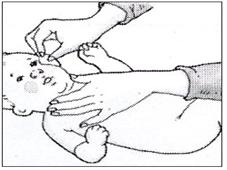
그림2-272.따뜻한 목욕 물을 적신 약솜구로 코 쪽에서 귀 쪽으로 눈 부위를 닦는다. 그 약솜구를 버리고 새 약솜구로 다른 쪽 눈 부위를 같은 방법으로 닦는다.
Copyright ⓒ 2011 John Sangwon Lee, MD., FAAP
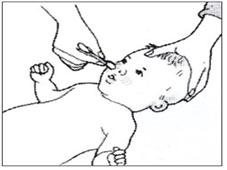
그림2-273.따뜻한 목욕 물을 적신 약솜구나 큐 팁으로 콧구멍 입구와 그 주위를 닦는다. 콧구멍 속은 닦지 않는다.
Copyright ⓒ 2011 John Sangwon Lee, MD., FAAP
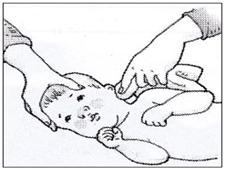
그림2-274.따뜻한 목욕 물을 적신 약솜구나 부드러운 수건으로 귓바퀴와 귀 뒤쪽 부위를 씻는다.
Copyright ⓒ 2011 John Sangwon Lee, MD., FAAP
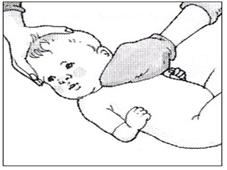
그림2-275.따뜻한 목욕 물을 적신 약솜구나 수건으로 얼굴을 씻고 마른 수건으로 살살 물기를 닦아 준다.
Copyright ⓒ 2011 John Sangwon Lee, MD., FAAP
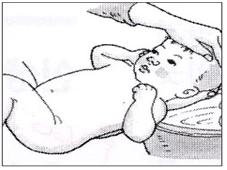
그림2-276.아기의 머리를 뒤로 살짝 젖힌 후 아기 샴푸나 비눗물로 머리를 감긴다.
Copyright ⓒ 2011 John Sangwon Lee, MD., FAAP
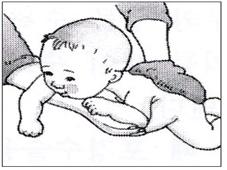
그림2-277.머리의 물기를 닦은 후 몸통을 비눗물로 씻고 마른 수건으로 물기를 닦아 준다.
Copyright ⓒ 2011 John Sangwon Lee, MD., FAAP
| 신생아 포경수술 받은 부위, 배꼽 닦기 |
- 포경수술로 생긴 자지 상처가 다 아물 때까지, 배꼽에 붙은 탯줄이 다 말라 떨어질 때까지 그 부위에 물이 묻지 않게 물 적신 약솜구나 거즈로 목욕시키는 것이 좋다.
- 목욕을 시키기 전에 기저귀만 채우고 옷을 전부 벗긴 후 담요나 포대기 등으로 아기를 춥지 않게 폭 싸고 다음과 같은 순으로 목욕시킨다. (부모도 반의사가 되어야한다-소아가정간호 백과-제21권 소아청소년 가정간호-약솜구, 거즈 참조)
| 신생아의 눈 닦기 |
- 아기 머리를 한쪽 손으로 받치고 다른 쪽 손으로 목욕물을 적신 약솜구를 살짝 짠다.
- 약솜구로 코 쪽에서 귀 있는 쪽으로 눈 부위를 씻는다.
- 이 때 안구를 씻어서는 안 된다.
- 세균이나 바이러스 등 병원체 감염으로 눈에 염증이 있을 때는 물론이고 눈에 염증이 없을 때도 약솜구로 눈 부위를 닦을 때 한 개의 약솜구로 한쪽 눈 부위만 닦은 후 그 약솜구를 버린다.
- 다른 새 약솜구로 다른 쪽 눈 부위를 같은 방법으로 닦아 준다.
- 목욕물을 적신 약솜구를 살짝 짜낸 후 양쪽 콧구멍 바깥 부위를 살짝 씻는다.
- 코를 씻을 때 목욕물이 콧구멍 속으로 들어가지 않게 주의한다.
- 약솜구를 콧구멍 속에 집어넣지도 말고 콧구멍 속을 씻어 주거나 후벼 주어서도 안 된다.

사진2-278.약솜구
Copyright ⓒ 2011 John Sangwon Lee, MD, FAAP
| 신생아의 귀 닦기 |
- 약솜구나 부드러운 목욕수건이나 거즈에 목욕물을 적셔 물을 짠 후 귓바퀴와 귓바퀴 뒤 부위를 씻어 준다.
- 이 때 목욕물이 귓구멍 속으로 들어갈까 걱정하지 않아도 된다.
- 목욕물이 귓구멍 속으로 조금 들어가도 들어간 목욕물이 자연히 뒤돌아 나오거나 쉽게 마른다.
- 또 귓구멍 속으로 들어간 목욕물이 외이도 속을 통과해서 중이 강 속까지 들어가지 않는다.
- 귓구멍 속이나 외이도 내 귀에지는 귓구멍 밖으로 자연히 나오는 것이 보통이다.
- 귓구멍 속 깊이 면봉이나 큐팁 등을 넣고 외이도 속을 후벼 주거나 씻어 주어서도 안 된다. (부모도 반의사가 되어야한다-소아가정간호 백과-제21권 소아청소년 가정간호-면봉, 제 18권 소아청소년 이비인후과 질환-귓구멍을 어떻게 닦아주나 참조)
| 신생아의 얼굴 닦기 |
- 엄마의 한쪽 손을 부드러운 목욕수건이나 거즈로 감싸고 그 수건이나 거즈에 목욕물을 적시고 살짝 짠 다음, 그 것으로 얼굴을 살살 씻어 준 후 부드러운 마른 수건으로 얼굴에 있는 물기를 닦아준다.
| 신생아의 머리 닦기 |
- 우선 아기를 포근히 싸고 엄마의 품에 안는다. 그 다음 엄마의 왼쪽 팔이나 오른쪽 팔과 손으로 아기의 등과 머리를 받혀 잡는다.
- 목욕물이나 비눗물이 아기의 얼굴로 흘러내리지 않게 아기의 머리를 뒤로 살짝 젖힌다. 그 다음, 물수건이나 물 묻은 거즈 등으로 아기의 머리를 적신 후, 베이비 샴푸나 비눗물을 아기의 머리에 바르고 손을 원형으로 돌리면서 머리를 부드럽게 감긴다.
- 물만 적신 수건이나 거즈 등으로 머리에서 맑은 물이 나올 때까지 비눗물이나 샴푸 물로 완전히 씻어 낸다.
- 그 다음 마른 수건으로 머리를 닦아준다.
- 대천문과 그 주위 부위를 닦아줄 때 혹시 대천문에 상처를 입힐까 걱정할 필요가 없다.
- 대천문을 닦아 줄 때도 머리의 다른 부위를 닦아줄 때와 같이 닦아주면 된다.
| 신생아의 몸통과 엉덩이 그리고 하지 닦기 |
- 머리를 먼저 씻은 다음 몸통과 엉덩이, 하지를 다음과 같이 닦아준다,
- 머리에 있는 물기를 다 말린 다음, 기저귀를 벗기고 몸통에 비눗물을 바른 후 부드러운 수건이나 거즈에 물을 적신 후 살짝 짠 다음 몸통을 씻어주고, 마른 수건으로 몸통, 겨드랑이, 턱밑, 사타구니 등에 있는 물기를 주의해서 닦아준다.
- 몸통, 엉덩이와 하지를 씻어 줄 때 포경수술로 생긴 상처나, 배꼽에 붙어 있는 탯줄에 목욕물이 묻지 않게 주의한다.
- 베이비파우더, 베이비 로션, 베이비오일, 향수 등을 될 수 있으면 뿌리지도 말고 발라 주지 않는 것이 좋다.
- 아기의 피부는 있는 그대로가 더 아름답고, 또 무엇이든지 아기의 피부에 바르면 그 바른 것으로 인해 피부염이 생길 가능성이 더 있기 때문이다.
- 아기의 피부에 피부병이 있을 때는 의사의 처방에 따라 적절한 파우더 피부약이나 피부 로션, 또는 크림 등으로 치료할 수 있다.
- 목욕시킨 후 아기에게 깨끗한 옷을 입히고 젖이나 인공영양을 먹인 다음 사랑하면서 재운다.
| 신생아 목욕통 목욕 |
Tub bath for newborn infants
- 생후 10∼14일경 배꼽에 붙어있던 탯줄이 말라서 완전히 떨어지는 것이 보통이다.
- 이런 것을 탯줄 건사라고 한다.
- 이 기간에 포경수술로 생긴 자지 상처도 다 아물고 낫는다.
- 이 때부터 목욕통 물속에서 아기 목욕을 시켜도 된다.
- 목욕통 속에 깊이 7㎝ 정도 목욕물을 붓는다.
- 목욕통 물 온도는 섭씨 38∼39도가 적당하다.
- 아기를 목욕통 물에 넣고 목욕시키기 전이나, 목욕시키는 중 아기가 미끄러지거나 긁혀 상처를 입지 않도록 깨끗한 목욕수건 하나를 목욕통 바닥에 깐다.
- 다음과 같은 순서로 목욕시킨다.
- 기저귀만 채운 채 입은 옷을 전부 벗긴 다음 부드러운 담요나 포대기로 몸통을 따뜻하게 싸준다.
- 물 묻은 약솜구나 거즈 등으로 목욕을 시킬 때와 같이 눈, 코, 귀, 얼굴, 머리 순서로 씻어 준다.
- 그 다음 찬 기저귀를 벗기고 엄마의 오른쪽 손을 아기의 오른쪽 겨드랑이 아래에 넣고, 오른 손 엄지손가락은 아기의 오른쪽 어깨 위에 올려놓는다. 이 때 오른쪽 팔과 팔목으로 아기의 뒷목과 뒤통수를 받쳐 준다.
- 그 다음 엄마의 왼쪽 손으로 아기의 엉덩이와 두 허벅다리를 잡고 목욕통 물속에 아기의 다리부터 천천히 넣는다.
- 아기의 몸통을 씻어줄 때 왼손으로 아기의 머리와 상체를 붙잡고, 오른손으로 목, 가슴, 배, 겨드랑이 등을 비눗물로 살살 씻어 준다.
- 그 다음 깨끗한 목욕물로 몸통에 묻은 비눗물을 씻어 낸다.
- 그 다음 외음부를 씻어 준다.
- 외음부를 씻을 때 물 적신 약솜구를 살짝 짠 후 약솜구로 외음부 쪽에서 항문 쪽을 향해 씻어 준다.
- 한 번 쓴 약솜구는 더 이상 쓰지 말고 버린다.
- 비눗물로 외음부와 항문과 그 주위를 씻어 준다.
- 마지막으로 다리를 씻어 주고 깨끗한 물로 비눗물을 씻어 낸다.
- 물론 바른손잡이나 왼손잡이에 따라 아기를 붙드는 방법과 닦는 손 선택도 다를 수 있다.
- 남아를 목욕시킬 때 포경수술을 받지 않은 남아의 자지 포피를 뒤집고 씻어 줄 필요가 없다.
- 포경수술을 받은 자지 끝 부위에 있는 귀두에 남아 있는 포피도 더 이상 까 줄 필요가 없다.
- 포경수술을 받은 후 약 1주일 정도 되면 포경수술을 받은 자지를 비눗물로 씻어 주어도 된다.
- 목욕을 다 시킨 다음 목욕통 물속에서 아기를 들어낸다.
- 따뜻하고 부드러운 목욕수건 위에 눕힌 후 몸에 묻은 물기를 닦아준다.
- 깨끗한 옷을 입히고 모유나 인공영양을 먹여 재운다.
- 기저귀를 찬 피부는 싼 대소변으로 인해 늘 습기가 차 축축할 수 있고 자극을 더 받을 수 있어 기저귀 피부염이 생기기 쉽다.
- 소변이나 대변을 싼 바로 후 기저귀를 곧 갈아주어 기저귀 피부염을 예방해야 한다.
- 기저귀 피부염을 예방하기 위해 베이비 파우더나 연고 등을 기저귀를 찬 부위 피부에 꼭
발라 줄 필요가 없다.
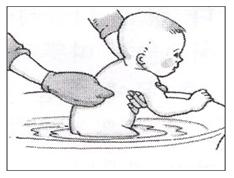
그림 2-281.몸통 씻기.
아기 몸통 앞부분을 먼저 닦고 아기를 전과 반대로 붙들고 등을 씻어준다. 외음부도 씻어준다.
Copyright ⓒ 2011 John Sangwon Lee, MD., FAAP
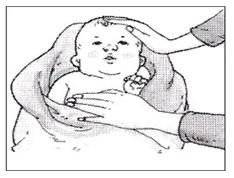
그림 2-282.목욕통 물 밖으로 꺼낸다. 아기를 떨어뜨리지 않도록 잘 잡고 들어올려 목욕수건 위에 눕힌다.
Copyright ⓒ 2011 John Sangwon Lee, MD., FAAP
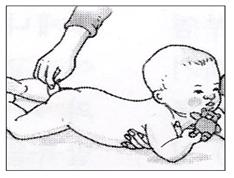
그림 2-283.기저귀 찬 부위 피부 손질.
의사의 지시에 따라 베이비 크림 등을 발라 줄 수 있다.
Copyright ⓒ 2011 John Sangwon Lee, MD., FAAP

그림 2-284.일반적인 피부 손질.
의사의 지시에 따라 아기용 로션이나 오일을 발라도 된다.
Copyright ⓒ 2011 John Sangwon Lee, MD., FAAP
Bath with sponges, cotton balls or gauzes 스폰지나 약솜구 또는 거즈로 목욕

Figure 2-272. Wipe the eyes from the nose to the ears with a cotton ball moistened with warm bathwater. Discard the cotton ball and wipe the other eye area with a new cotton ball in the same way. Copyright ⓒ 2011 John Sangwon Lee, MD., FAAP

Figure 2-273. Wipe the mouth of the nostril and the area around it with a cotton ball or cue tip moistened with warm bathwater.
Don’t wipe the inside of your nostrils. Copyright ⓒ 2011 John Sangwon Lee, MD., FAAP

Picture 2-274. Wash the auricle and the back of the ear with a cotton pad or soft towel moistened with warm bathwater. Copyright ⓒ 2011 John Sangwon Lee, MD., FAAP

Picture 2-275. Wash your face with a cotton pad or towel moistened with warm bath water, and gently wipe the water with a dry towel. Copyright ⓒ 2011 John Sangwon Lee, MD., FAAP

Picture 2-276. Tilt the baby’s head back slightly and wash the baby’s hair with baby shampoo or soapy water. Copyright ⓒ 2011 John Sangwon Lee, MD., FAAP

Figure 2-277. After wiping the moisture from the head, wash the body with soapy water and dry it with a dry towel. Copyright ⓒ 2011 John Sangwon Lee, MD., FAAP
Newborn circumcised area, navel cleaning
- It is better to take a bath with water-soaked cotton pads or gauze to prevent water from getting on the area until the circumcision has healed and the umbilical cord attached to the navel is completely dry.
- Before taking a bath, just putting diapers, take off all clothes, wrap the baby with a blanket or a wrapper so that it doesn’t get cold, and take a bath in the following order. (Parents should also be at least the half-doctors-Refer to the Encyclopedia of Child and Family Nursing-Volume 21, Family Nursing for Children and Adolescents-cotton ball, Gauze)
Cleaning the newborn’s eyes
- Support the baby’s head with one hand and lightly squeeze a cotton ball moistened with the bathwater with the other hand.
- Wash the eye area from the nose side to the ear side with a cotton ball.
- Do not wash your eyes at this time.
- When the eye is inflamed by a pathogen infection such as bacteria or virus, as well as when the eye is not inflamed, when cleaning the eye area with a cotton ball, wipe only one eye area with a cotton ball and discard the cotton ball.
- Use another new cotton ball to wipe the other eye area in the same way.
Lightly squeeze out a cotton ball soaked in bathwater, then gently wash the outer areas of both nostrils.
- When washing your nose, be careful not to let the bathwater get into your nostrils.
- Do not put the cotton ball into the nostril,
- and do not wash or scrub the inside of the nostril.

Picture 2-278. Cotton balls.Copyright ⓒ 2011 John Sangwon Lee, MD, FAAP
Cleaning the newborn’s ears
- Wash the auricle and the area behind the auricle after squeezing the water with a cotton ball or soft bath towel or gauze.
- At this time, you don’t have to worry about the bathwater going into your ear canal.
- Even if the bathwater gets into the ear canal, the bathwater comes out naturally or dries easily.
- Also, the bathwater that went into the ear canal passes through the ear canal and does not go into the middle ear. It is common for the inner ear or outer ear to naturally come out of the ear hole in my ear.
- Do not put a cotton swab or cue tip deep into the ear canal and scrub or wash the inside of the ear canal. (Parents should also be at least the half-doctors-Refer to the Encyclopedia of Child and Family Nursing-Vol. 21, Family Nursing for Children and Adolescents-Cotton swabs, Vol. 18, Children and Adolescent Otolaryngology-How to Clean the Ear Holes)
Cleaning the newborn’s face
- Wrap one of the mother’s hands with a soft bath towel or gauze, moisten the towel or gauze with the bathwater, squeeze it slightly, and gently wash the face with it, and then wipe the water off the face with a soft dry towel.
Washing the newborn’s hair
- First, wrap the baby warmly and hold it in the mother’s arms.
- Then, with her mother’s left or right arm and her hand, hold her baby’s back and her head back.
- Tilt the baby’s head slightly to prevent the bathwater or soapy water from dripping down the baby’s face.
- Then, after moistening the baby’s head with a wet towel or water-soaked gauze, apply baby shampoo or soapy water to the baby’s head, and gently wrap her hair while turning her hand in a circle.
- Wash thoroughly with soapy water or shampoo water until clear water comes out of your hair with a water-only towel or gauze. Then, wipe your hair with a dry towel.
- When cleaning the anterior fontanel and its surrounding areas, there is no need to worry about damaging the anterior fontanel.
- When cleaning the anterior fontanel, you can wipe it the same way as when cleaning other parts of the head.
Cleaning the newborn’s torso, buttocks, and legs
Wash his head first, then clean your torso, buttocks, and lower extremities as follows,
After drying all the moisture on the head, remove the diaper, apply soapy water to the body, wet a soft towel or gauze, squeeze it slightly, and then wash the body.
And wipe it off. When washing the torso, buttocks, and lower limbs, be careful not to get the bathwater on the umbilical cord attached to the belly button or wounds caused by circumcision.
Baby powder, baby lotion, baby oil, perfume, etc., if possible, do not spray and do not apply.
The baby’s skin is more beautiful as it is, and if anything is applied to the baby’s skin, it is more likely to cause dermatitis.
When there is a skin disease on the baby’s skin, it can be treated with an appropriate powder skin medicine, skin lotion, or cream according to the doctor’s prescription.
After bathing, put on clean clothes, feed the baby with breast milk or artificial nutrition, and sleep with love. Newborn baby bathtub
Tub bath for newborn infants
- Around 10-14 days after birth, the umbilical cord attached to the belly button dries up and falls completely.
- This is called umbilical cord health. During this period, any wounds on the cock caused by circumcision are healed and healed.
- From this point on, you can bathe your baby in the water in the bathtub.
- Pour bathwater about 7 cm deep into the bathtub.
- The bathtub water temperature is appropriate at 38-39 degrees Celsius.
- Put a baby in the bathtub water and put a clean bath towel on the bottom of the bathtub to prevent the baby from slipping or scratching before or during bathing.
- Take a bath in the following order.
- Take off all the clothes you wear with only diapers, and wrap your body warm with a soft blanket or sack.
- Wash his eyes, nose, ears, face, and head in the same order as when bathing with a cotton ball or gauze soaked in water.
- Then, remove the cold diaper, place the mother’s right hand under the baby’s right armpit, and place the thumb of the right hand over the baby’s right shoulder.
- At this time, support the baby’s back neck and back head with the right arm and wrist.
- Then grab her baby’s buttocks and both thighs with her mother’s left hand and slowly place her baby’s legs into her bathtub in the water.
- When washing the baby’s body, hold the baby’s head and upper body with her left hand, and gently wash her neck, chest, stomach, and armpits with soapy water with her right hand.
- Then, wash off the soapy water from the body with clean bathwater.
- Then wash the vulva. When washing the vulva, lightly squeeze a cotton ball moistened with water, and then use a cotton ball to wash it from the vulva to the anus.
- Do not use the cotton ball once used and discard it.
- Wash the vulva, anus, and the area around it with soapy water.
- Finally, wash your baby’s legs and wash off the soapy water with clean water.
- Of course, depending on the right-handed or left-handed, the method of holding the baby and the choice of wiping hand can be different.
- When bathing a boy, there is no need to turn over and wash the foreskin of a boy who has not undergone circumcision.
- It is no longer necessary to open the foreskin remaining on the glans at the tip of the penis that has undergone circumcision.
- You may wash your circumcised penis with soapy water about a week after receiving circumcision. After the bath is finished, lift the baby out of the tub.
- Lay it on a warm, soft bath towel and wipe off any water from your body.
- Put on clean clothes and feed them with breast milk or artificial nutrition to sleep.
- Diapered skin is always moist and moist due to cheap stool and can get more irritation, so it’s easy to get diaper dermatitis.
- Diaper rash should be prevented by changing diapers immediately after urinating or stooling.
- To prevent diaper dermatitis, make sure to apply baby powder or ointment to the skin of the area covered with the diaper. There is no need to apply it.

Figure 2-281. Washing the body. Wipe the front part of the baby’s body first, hold the baby in the opposite direction, and wash the back. Wash the vulva as well. Copyright ⓒ 2011 John Sangwon Lee, MD., FAAP

Figure 2-282. Take out the bathtub water. Hold the baby well so as not to drop it, lift it, and lay it on a bath towel. Copyright ⓒ 2011 John Sangwon Lee, MD., FAAP

Figure 2-283. Skincare for cold diapers. You can apply baby cream, etc., as directed by your doctor. Copyright ⓒ 2011 John Sangwon Lee, MD., FAAP

Figure 2-284. Typical skin care. You can also apply baby lotions or oils as directed by your doctor. Copyright ⓒ 2011 John Sangwon Lee, MD., FAAP
출처 및 참조문헌
- NelsonTextbook of Pediatrics 22ND Ed
- The Harriet Lane Handbook 22ND Ed
- Growth and development of the children
- Red Book 32nd Ed 2021-2024
- Neonatal Resuscitation, American Academy Pediatrics
- www.drleepediatrics.com 제1권 소아청소년 응급 의료
- www.drleepediatrics.com 제2권 소아청소년 예방
- www.drleepediatrics.com 제3권 소아청소년 성장 발육 육아
- www.drleepediatrics.com 제4권 모유,모유수유, 이유
- www.drleepediatrics.com 제5권 인공영양, 우유, 이유식, 비타민, 미네랄, 단백질, 탄수화물, 지방
- www.drleepediatrics.com 제6권 신생아 성장 발육 육아 질병
- www.drleepediatrics.com제7권 소아청소년 감염병
- www.drleepediatrics.com제8권 소아청소년 호흡기 질환
- www.drleepediatrics.com제9권 소아청소년 소화기 질환
- www.drleepediatrics.com제10권. 소아청소년 신장 비뇨 생식기 질환
- www.drleepediatrics.com제11권. 소아청소년 심장 혈관계 질환
- www.drleepediatrics.com제12권. 소아청소년 신경 정신 질환, 행동 수면 문제
- www.drleepediatrics.com제13권. 소아청소년 혈액, 림프, 종양 질환
- www.drleepediatrics.com제14권. 소아청소년 내분비, 유전, 염색체, 대사, 희귀병
- www.drleepediatrics.com제15권. 소아청소년 알레르기, 자가 면역질환
- www.drleepediatrics.com제16권. 소아청소년 정형외과 질환
- www.drleepediatrics.com제17권. 소아청소년 피부 질환
- www.drleepediatrics.com제18권. 소아청소년 이비인후(귀 코 인두 후두) 질환
- www.drleepediatrics.com제19권. 소아청소년 안과 (눈)질환
- www.drleepediatrics.com 제20권 소아청소년 이 (치아)질환
- www.drleepediatrics.com 제21권 소아청소년 가정 학교 간호
- www.drleepediatrics.com 제22권 아들 딸 이렇게 사랑해 키우세요
- www.drleepediatrics.com 제23권 사춘기 아이들의 성장 발육 질병
- www.drleepediatrics.com 제24권 소아청소년 성교육
- www.drleepediatrics.com 제25권 임신, 분만, 출산, 신생아 돌보기
- Red book 29th-31st edition 2021
- Nelson Text Book of Pediatrics 19th- 21st Edition
- The Johns Hopkins Hospital, The Harriet Lane Handbook, 22nd edition
- 응급환자관리 정담미디어
- Pediatric Nutritional Handbook American Academy of Pediatrics
- 소아가정간호백과–부모도 반의사가 되어야 한다, 이상원 저
- The pregnancy Bible. By Joan stone, MD. Keith Eddleman, MD
- Neonatology Jeffrey J. Pomerance, C. Joan Richardson
- Preparation for Birth. Beverly Savage and Dianna Smith
- 임신에서 신생아 돌보기까지. 이상원
- Breastfeeding. by Ruth Lawrence and Robert Lawrence
- Sources and references on Growth, Development, Cares, and Diseases of Newborn Infants
- Emergency Medical Service for Children, By Ross Lab. May 1989. p.10
- Emergency care, Harvey Grant and Robert Murray
- Emergency Care Transportation of Sick and Injured American Academy of Orthopaedic Surgeons
- Emergency Pediatrics A Guide to Ambulatory Care, Roger M. Barkin, Peter Rosen
- Quick Reference To Pediatric Emergencies, Delmer J. Pascoe, M.D., Moses Grossman, M.D. with 26 contributors
- Neonatal resuscitation Ameican academy of pediatrics
- Pediatric Nutritional Handbook American Academy of Pediatrics
- Pediatric Resuscitation Pediatric Clinics of North America, Stephen M. Schexnayder, M.D.
-
Pediatric Critical Care, Pediatric Clinics of North America, James P. Orlowski, M.D.
-
Preparation for Birth. Beverly Savage and Dianna Smith
-
Infectious disease of children, Saul Krugman, Samuel L Katz, Ann A.
- 제4권 모유, 모유수유, 이유 참조문헌 및 출처
- 제5권 인공영양, 우유, 이유, 비타민, 단백질, 지방 탄수 화물 참조문헌 및 출처
- 제6권 신생아 성장발육 양호 질병 참조문헌 및 출처
- 소아과학 대한교과서
|
Copyright ⓒ 2015 John Sangwon Lee, MD., FAAP 미국 소아과 전문의, 한국 소아청소년과 전문의 이상원 저 “부모도 반의사가 되어야 한다”-내용은 여러분들의 의사로부터 얻은 정보와 진료를 대신할 수 없습니다. The information contained in this publication should not be used as a substitute for the medical care and advice of your doctor. There may be variations in treatment that your doctor may recommend based on individual facts and circumstances. “Parental education is the best medicine.” |